This post has been migrated over from my original Substack account. This is its new home, so make sure you’re following me here to stay connected! Some images and other formatting may have been lost in the move – sorry about that.
This week, a potter around another local patch I love. There are more than 8,000 ‘Commons’ in England, and where I live many of them are bordered or dissected by chalk streams. Which is very fortunate – there are only 210 chalk streams in the world. With 85% of those right here in the UK, they are both statistically special and completely magical.
Chalk streams naturally run very clear. They vary in size and can get wide, deep and fast moving, but they often flow gently too. Which is perfect for one of our most enigmatic species of bird.
Kingfishers
I really didn’t want to write about Kingfishers here until I had a crisp photo of one, but they are tricksy little things! I also don’t want to describe them as a flash of blue, streaking down the river before you even realise they’re there.
But that’s all I’ve seen of them so far this year, so it’s what you get.*
The reason I have to mention them right now is that it is undoubtedly the best time to go and find one. For one, the water levels are lower. My local chalk stream normally turns into a brown deluge when it’s swollen with April showers. This forces the Kingfishers to head to shallower streams, often lined by dense undergrowth.
But, with very little rainfall this year, the Kingfishers are nesting and fishing all the way along the banks of the larger (more accessible) river.
Secondly, the young seem to have emerged from the nests very recently. You can tell, because every few minutes there is an explosive PEEP PEEP sound coming from upstream, downstream or behind the riverside bushes. The adults are both hunting and keeping an eye out for danger. That call sounds like a blast on a referee’s whistle and it is often followed by a flurry of activity.
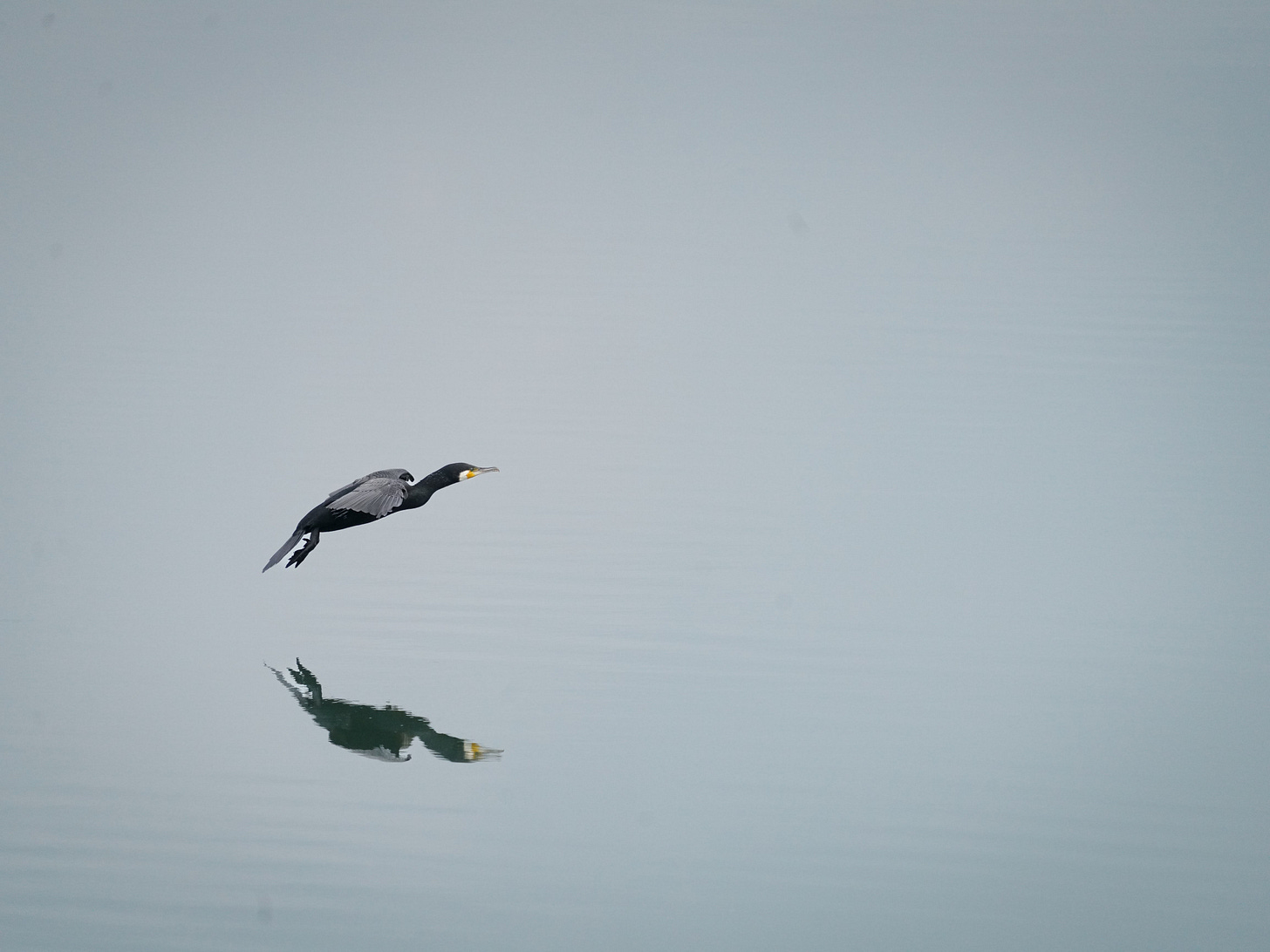
If you want to actually see a Kingfisher perched… well, that’s a different ballgame. This is where you put your fieldcraft to the test. Here are some things you can do to maximise your chance of seeing one in its classic pose:
Wear clothing in natural colours, such as browns and greens.
Move quietly - avoid stepping on gravel, dry leaves and sticks.
Move steadily, planting one foot, transferring your weight onto it, and then moving the other. It sounds a bit odd, but this ‘stalking’ movement means you move slowly enough not to attract attention to your movement, and can also prevent you from losing your footing.
As you move, scan the overhanging branches at the side of the river. They can also perch on reeds and the fronds of willow trees, so take your time.
If you see one, you might be tempted to shuffle into a better position. At first, try just to wait.
Watch.
One wrong move and they will shoot off into the distance.
But if you hold still, there’s no sound more exciting than a Kingfisher plopping into the water then splashing back out of the stream and into the air.
If successful, they will likely perch and bash their fish onto a branch to stun or kill it. Then, they may fly off to feed their young and return. If unsuccessful, they may try again from the same spot.
You can sex a Kingfisher easily from even a relatively poor photo. The male has an all dark grey/black beak. The female’s lower bill (or ‘mandible’) is orange – I remember it as ‘lipstick’. And juveniles of both sexes have a pale white tip at the end of the bill.
*The day I published this, I went to the Common and put all these tricks to the test. I did manage to spot a Kingfisher perched, though only for long enough to get a low-res shot. Then a spaniel appeared and the fun was over!
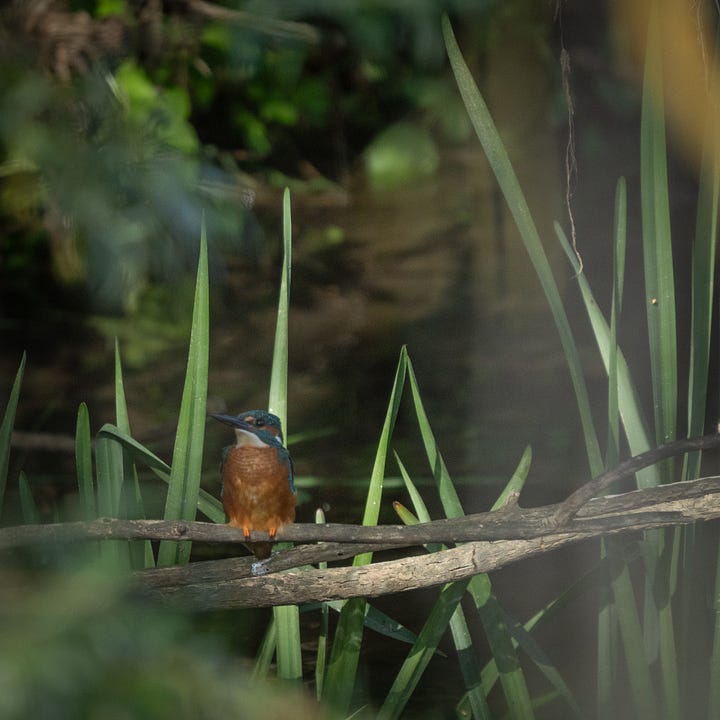
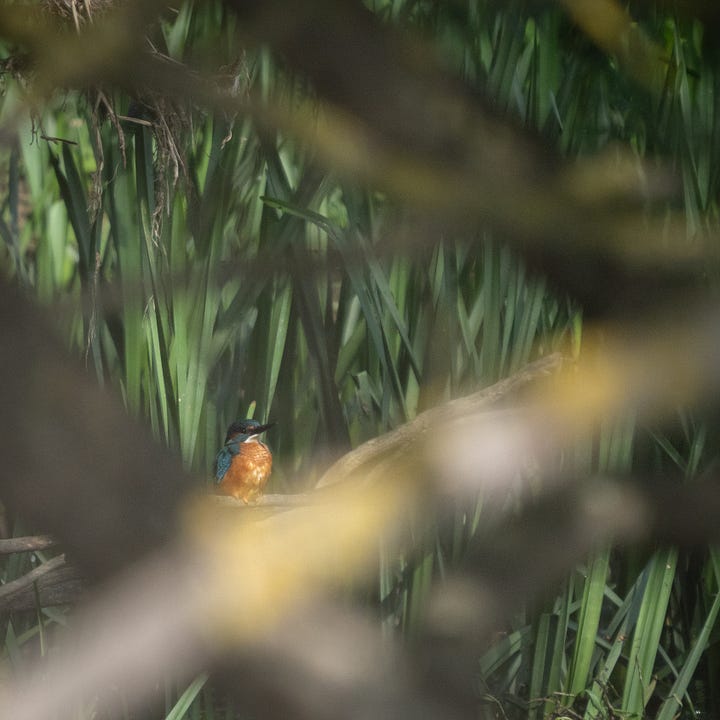
Buntings, wagtails and warblers
Once the Kingfisher has moved on (always too soon) there’s still plenty to see. Chalk streams often have one steeper side with reeds, opposite the path. In those reeds you’ll hear the mechanical chirping of Sedge Warblers, the chaotic song of the Reed Warbler and the repetitive call of Reed Buntings (heard in my video, below).
Watch closely for reeds moving around and you might spot the birds as they make their way along the riverbank catching insects. The Reed Buntings often perch at the top, singing. The males have a striking black head with a white collar. Very photogenic (and far easier to capture than the warblers). Grey Wagtails also run frantically up and down shore lines and over rocks to catch little insects.
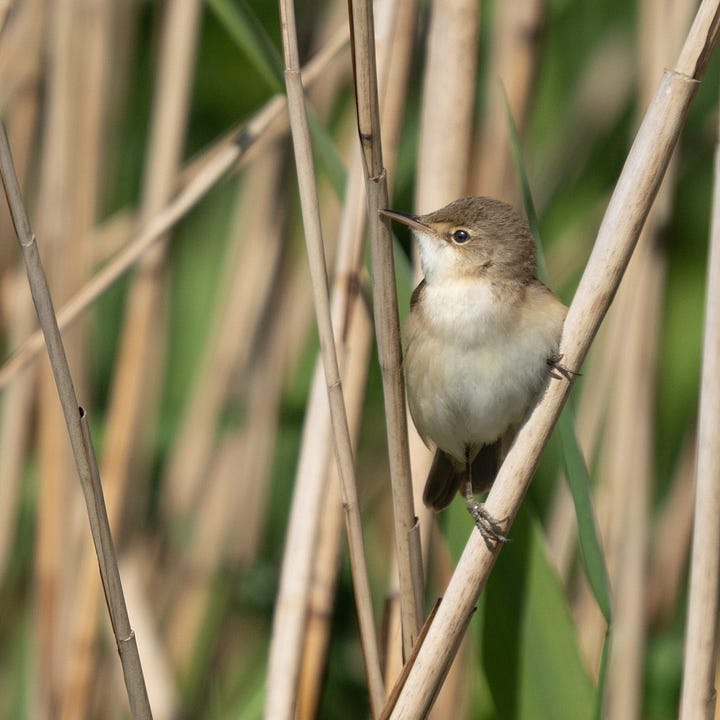
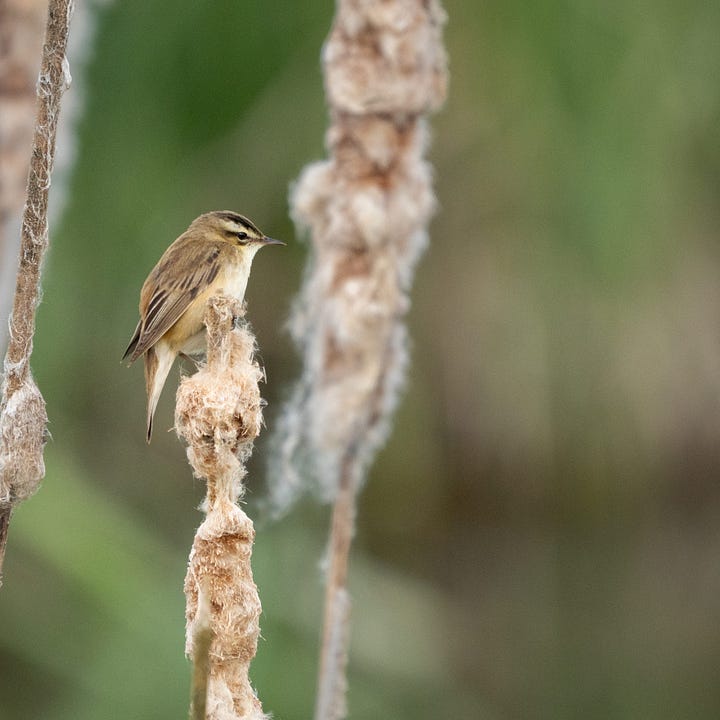
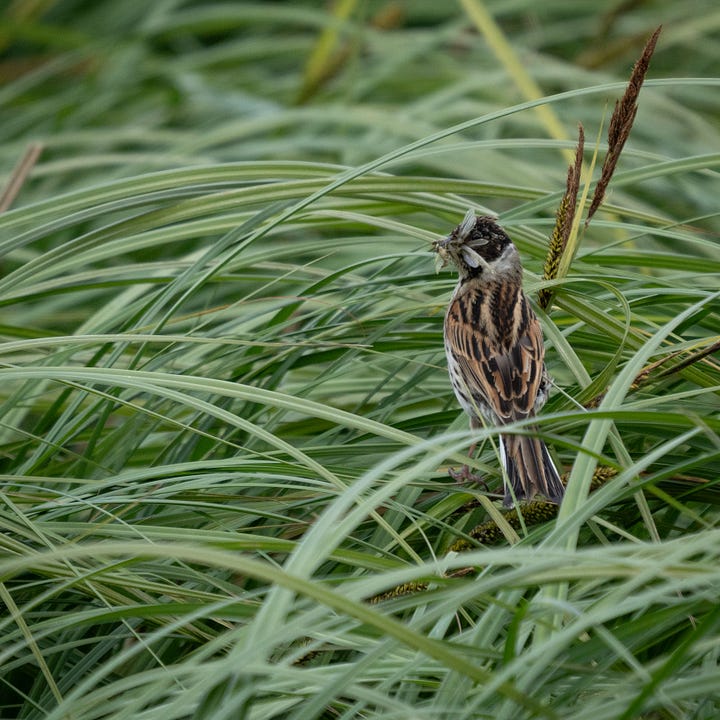
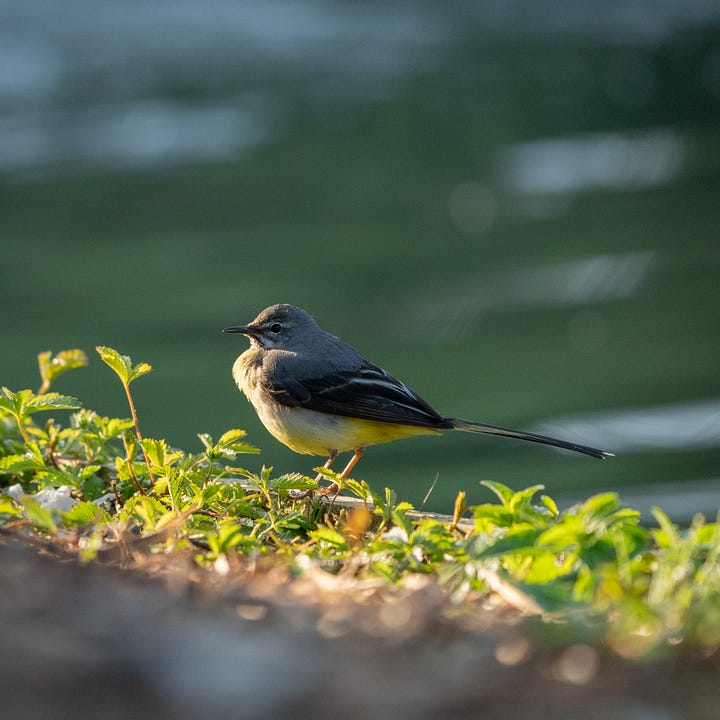
You might also see, or hear, the sudden exclamation of a Moorhen as it ushers its (ugly) babies to safety. Or perhaps, deep in the reeds, the squealing pig sound of a rare and illusive Water Rail. These look similar to the more common Moorhen, but they are brown and blue-ish grey. Spotting one of these is a very lucky occurrence.
No (r)Egrets
Little Egrets seem to be present in almost any waterway - a conservation success story if ever there was one. These elegant creatures were hunted to almost extinction to adorn hats with their feathers. Fortunately, a woman named Emily Williamson gathered some allies and set up what is now the RSPB in order to save them.
“Emily, from Didsbury, Greater Manchester, was angry that the all-male British Ornithologist’s Union was doing nothing to protect these birds from becoming a fashion accessory. Others too were determined to protect wild birds from the whims of fashion, and Emily Williamson joined forces with Eliza Phillips of the Fur, Fin and Feather Folk of Croydon, Etta Lemon and Winifred Cavendish-Bentinck, Duchess of Portland.” – RSPB
My only slight gripe with little egrets is the way they fly. The pull their head in with their neck folded beneath it, which – from a distance – makes them look for all the world like a Barn Owl. Well, it does when it’s 5am and you’re in the half light desperately trying to spot a Barn Owl, anyway.
Otters, fishes and foxes
Back to the chalk stream on our Common – from which you can take a gentle hike to the RSPB headquarters. It is also home to plenty of wonderful non-bird critters. From brown trout and dragonflies up to deer, foxes and even otters.
I was lucky enough to spot three wild otters in this stretch of water while walking my (very much on-lead) dog one morning. I heard what sounded like something thrashing in the water. I assumed it was a Coot or Mallard having a tantrum, especially as otters are apparently only seen very early in the day and are painfully shy.
But there they were, playing and fishing very successfully. Jasper and I watched until they disappeared from view. I still check that stretch of water every time I pass by, three years on.
The joys of a Common
It was a warm, hazy day that I last visited the Common. The sound of the Cuckoo distorted with the wind, sounding like panpipes being played up close, then farther away, then up close again.
And there was a constant aerial presence – Buzzards, Red Kites and kestrels. There must be thousands of mice and voles to feed them all, and the owls that come out later in the day.
The water runs so clear in chalk streams, it’s hard to resist the temptation to take off your walking boots and socks to paddle. The water is a very consistent 10–11 degrees Celsius, so it’s bracing (at best) on all but the hottest days. I still can’t resist.
And for people who are non-serious birders (like me), there is endless fun to be had watching dogs hurling themselves into the shallows after a ball. I particularly enjoy meeting the ones who just have to show off how absolutely soaking wet they are. I love making new doggy friends, even when they’ve just appeared out of nowhere and flushed the wildlife away. (I didn’t want to photograph that Kingfisher anyway).
Through my lens
Below is a minute of footage from the riverbank. Nothing happens, and being a Common you can hear trains in the background. But you can also hear the steady ‘cheep, cheep, trillll’ of a Reed Bunting, the background chatter of Reed and Sedge Warblers, the ‘dweeeep’ of a Chiffchaff and I think even the ‘pee-eep’ of an Oystercatcher.
These enormous wild roses stopped me in my tracks. A few feet away, the first poppies of the year were vying for my attention, too.
Your turn
I’d love to hear about your encounters with nature, wherever you are in the world. What have you seen this week, while I was chasing Kingfishers at the Common?
If this made you smile or inspired you to go looking for nature, a little tap of the ‘Subscribe’ or ‘Like’ buttons goes a long way. Thanks for reading!
P.S. I’m also a freelance professional writer. I work with purpose-led organisations who are making the world a better place. If that’s you and you want to produce content, but don’t have time to do it yourself, get in touch!





